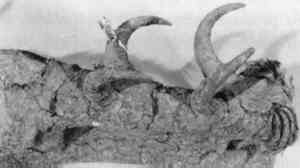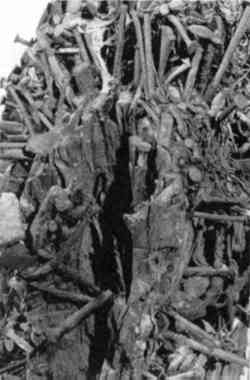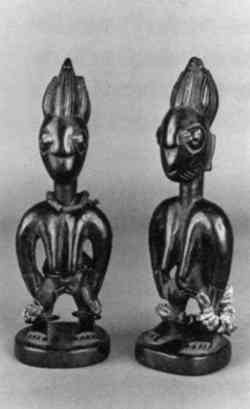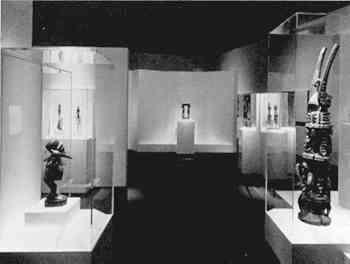THE EXHIBITION AND CONSERVATION OF AFRICAN OBJECTS: CONSIDERING THE NONTANGIBLE
STEPHEN P. MELLOR
1 INTRODUCTION
Many people in Western cultures view African objects as culturally foreign and aesthetically challenging while readily acknowledging their nontangible attributes. Yet these nontangible attributes are often poorly defined and considered not only incomprehensible but also potentially dangerous. These attributes might include the concepts that objects embody supernatural spirits, personify ancestors, or maintain power inherently. As conservators, we work intimately on these objects; we understand the physical and chemical properties of these sometimes complex constructions, but their nontangible aspects can still remain difficult curiosities that are partially addressed through courteous but uninformed acknowledgment, benign disregard, or even outright fear. This paper is an attempt to look at these nontangible attributes associated with African objects and how these attributes affect treatment decisions that we make in a nonindigenous setting, that is, in art conservation laboratories, studios, or exhibition planning meetings.
Some specific examples in African art where nontangible attributes might have an effect on treatment decisions can be seen in the following:
- Should we look inside a Yoruba beaded crown (fig. 1), considered to be the premier piece of divine regalia, to mend the textile lining (fig. 2), or lend slides of its interior to the education department, when in cultural context it is forbidden for anyone, including the king, to view the interior?
- Should we secure loose and detached fragments of sacrificial patination on a Bamana Komo headdress (fig. 3), when the amount and thickness of this incrustation (fig. 4) are directly related to the degree and effectiveness of its cultural power?
- Should we mend the shattered arm on a Kongo nkisi figure (figs. 5–6), when culturally, destroying the object might be the only way to mitigate its unrestrainable power?
- Should we feed, bathe, caress, or store in a particular manner a Yoruba ibeji(figs. 7–8) to placate the spirit of a deceased twin so that it does not call for the spirit of the surviving twin or its descendants?
- How do we justify the public exhibition of an Igala shrine figure (fig. 9), which would have been restricted from public view and seen only by people of a specific age, sex, or initiate?
Fig. 1.
Crown, Yoruba peoples, Nigeria, Glass beads, basketry, textile, vegetable fiber, metal, H 30 � in (78. 1cm). NMAfA 24-1989-01 (private lender). Photograph by Jeffrey Ploskonka
 |
Fig. 2.
Detail of fig. 1. Photograph by Dana Moffett
 |
Fig. 3.
Komo headdress, Bamana peoples, Mali, Wood, horn, porcupine quill, hair, metal, incrustation, Diam. 32 � in (83.2cm). Seattle Art Museum, Katherine White Collection 81.17.18. Photograph by Steve Mellor
 |
Fig. 4.
Detail of fig. 3. Photograph by Steve Mellor
 |
Fig. 5.
Nkisi, Kongo peoples, Zaire, Wood, iron, Beads, vegetable fiber, glass, feathers, chalk, resin, H 31 11/16 in (81.4cm). Seattle Art Museum, Katherine White Collection 81.17.836. Photograph by Steve Mellor
 |
Fig. 6.
Detail of fig. 5; Proper right arm. Photograph by Steve Mellor
 |
Fig. 7.
Female twin figures (ere ibeji), Yoruba peoples, Nigeria, Wood, shell, vegetable fiber, takula, glass beads, pigment. H10 � in (26.6cm). NMAfA 83-6-1.1, 1.2. Photograph by Ken Heinen
 |
Fig. 8.
Caretaker with memorial figures, representing three generations of twins in her family. Egbado, Yoruba. Photograph by Henry J. Drewal
 |
Fig. 9.
(top) Icons: Ideals and Power in the Art of Africa, exhibition at the National Museum of African Art, 1898–90
 |
Africa is two and one-half times the size of the United States, contains 44 sub-Saharan countries, and thousands of linguistic and traditional cultural groups. These factors—coupled with Africa's distance from the United States and its relative geographic inaccessibility, as well as the impact of culture change over time due to politics, religion, or colonialization—make access to the people who can best interpret an object's nontangible attributes difficult. In addition, Africa lacks transcontinental advocacy groups who might actively address material culture issues.
It is the intention in this paper to ascertain an indigenous perspective: how Africans feel about nontangible attributes, how Africans might view objects out of their cultural context, and how Africans might want us to treat their culturally significant objects.
|








